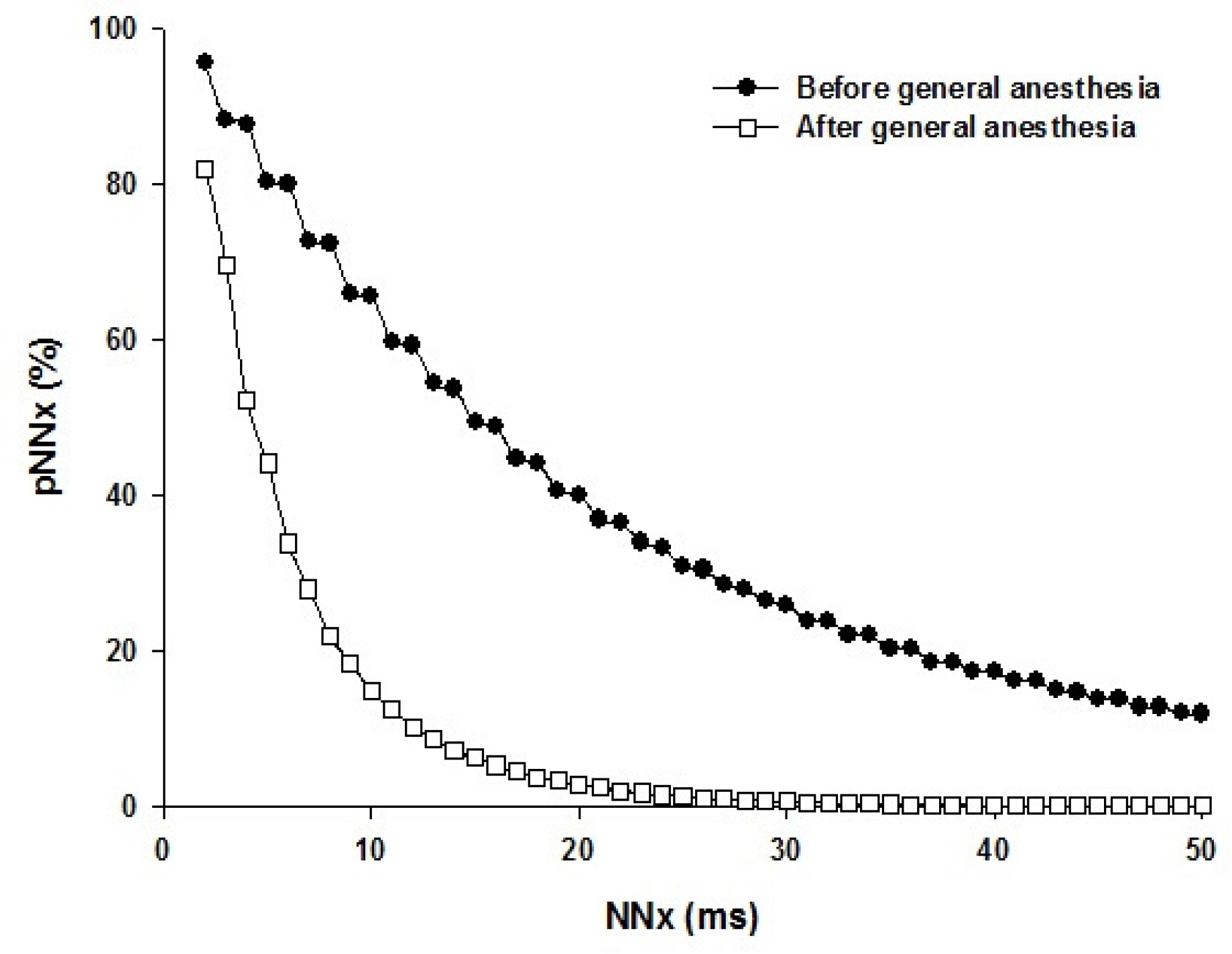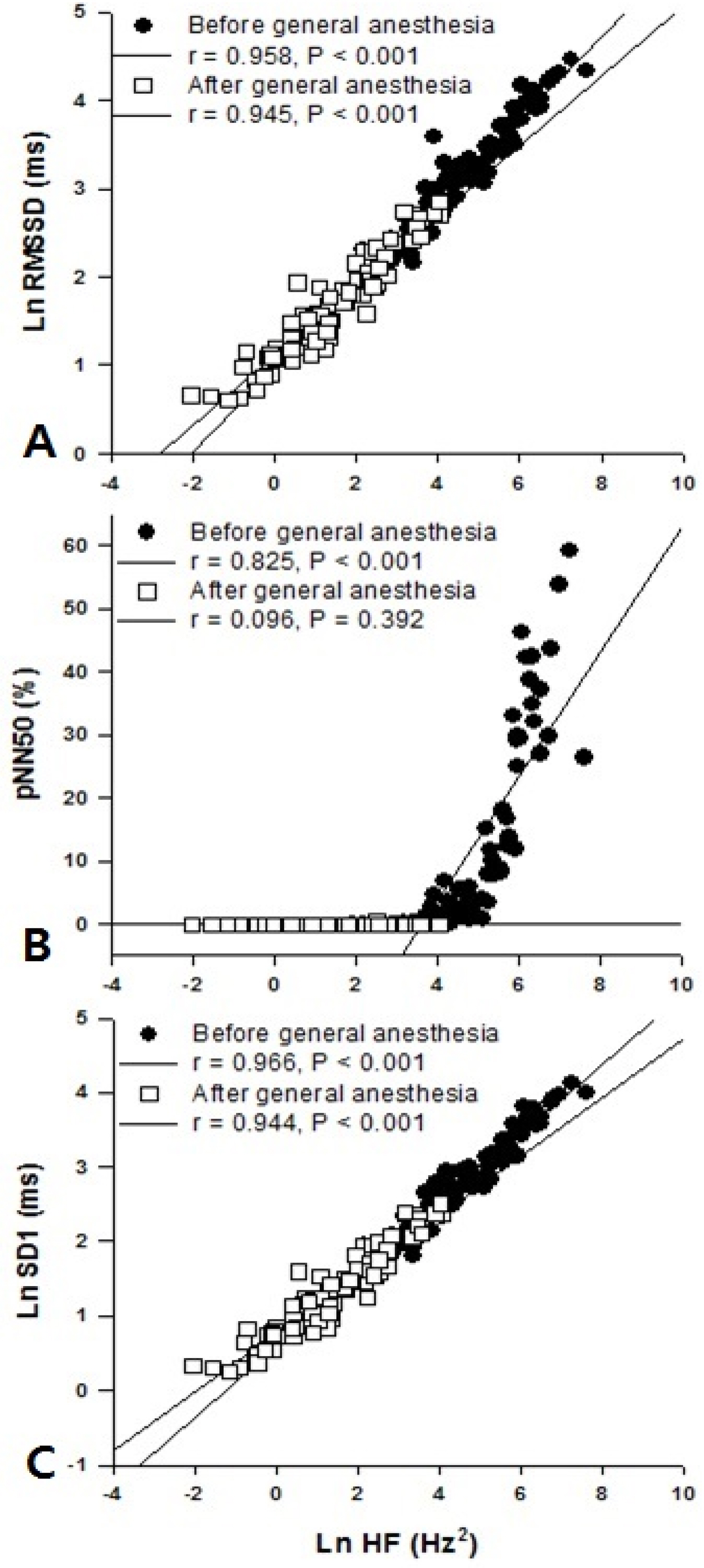Kosin Med J.
2018 Dec;33(3):369-379. 10.7180/kmj.2018.33.3.369.
Relation of Various Parameters Used to Estimate Cardiac Vagal Activity and Validity of pNN50 in Anesthetized Humans
- Affiliations
-
- 1Department of Anesthesiology and Pain Medicine, Ulsan University Hospital, College of Medicine, Ulsan University, Ulsan, Korea. huhiy@naver.com
- KMID: 2442547
- DOI: http://doi.org/10.7180/kmj.2018.33.3.369
Abstract
OBJECTIVES
Analysis of heart rate variability (HRV) has been used as a measure of cardiac autonomic function. According to the pNN50 statistic, the percentage of differences between successive normal RR intervals (RRI) that exceed 50 ms, has been known to reflect cardiac vagal modulation. Relatively little is known about the validity of pNN50 during general anesthesia (GA). Therefore, we evaluated the correlation of pNN50 with other variables such as HF, RMSSD, SD1 of HRV reflecting the vagal tone, and examined the validity of pNN50 in anesthetized patients.
METHODS
We assessed changes in RRI, pNN50, root mean square of successive differences of RRI (RMSSD), high frequency (HF) and standard deviation 1 (SD1) of Poincaré plots after GA using sevoflurane anesthesia. We also calculated the probability distributions for the family of pNNx statistics (x: 2-50 ms).
RESULTS
All HRV variables were significantly decreased during GA. HF power was not correlated with pNN50 during GA (r = 0.096, P = 0.392). Less than pNN47 was shown to have a correlation with other variables.
CONCLUSIONS
These data suggest that pNN50 can not reflect the level of vagal tone during GA.
Keyword
Figure
Reference
-
1.Heart rate variability: standards of measurement, physiological interpretation and clinical use. Task Force of the European Society of Cardiology and the North American Society of Pacing and Electrophysiology. Circulation. 1996. 93:1043–65.2.Akselrod S., Gordon D., Ubel FA., Shannon DC., Berger AC., Cohen RJ. Power spectrum analysis of heart rate fluctuation: a quantitative probe of beat-to-beat cardiovascular control. Science. 1981. 213:220–2.
Article3.Fleisher LA. Heart rate variability as an assessment of cardiovascular status. J Cardiothorac Vasc Anesth. 1996. 10:659–71.
Article4.Vongpatanasin W., Taylor JA., Victor RG. Effects of cocaine on heart rate variability in healthy subjects. Am J Cardiol. 2004. 93:385–8.
Article5.Ewing DJ., Neilson JM., Travis P. New method for assessing cardiac parasympathetic activity using 24 hour electrocardiograms. Br Heart J. 1984. 52:396–402.
Article6.Voss A., Kurths J., Kleiner HJ., Witt A., Wessel N., Saparin P, et al. The application of methods of non-linear dynamics for the improved and predictive recognition of patients threatened by sudden cardiac death. Cardiovasc Res. 1996. 31:419–33.
Article7.Silipo R., Deco G., Vergassola R., Gremigni C. A characterization of HRV's nonlinear hidden dynamics by means of Markov models. IEEE Trans Biomed Eng. 1999. 46:978–86.
Article8.Busjahn A., Voss A., Knoblauch H., Knoblauch M., Jeschke E., Wessel N, et al. Angiotensin-converting enzyme and angiotensinogen gene polymorphisms and heart rate variability in twins. Am J Cardiol. 1998. 81:755–60.9.Mietus JE., Peng CK., Henry I., Goldsmith RL., Goldberger AL. The pNNx files: reexamining a widely used heart rate variability measure. Heart. 2002. 88:378–80.
Article10.Donchin Y., Feld JM., Porges SW. Respiratory sinus arrhythmia during recovery from isoflurane-nitrous oxide anesthesia. Anesth Analg. 1985. 64:811–5.
Article11.Bäcklund M., Toivonen L., Tuominen M., Pere P., Lindgren L. Changes in heart rate variability in elderly patients undergoing major noncardiac surgery under spinal or general anesthesia. Reg Anesth Pain Med. 1999. 24:386–92.
Article12.Kato M., Komatsu T., Kimura T., Sugiyama F., Nakashima K., Shimada Y. Spectral analysis of heart rate variability during isoflurane anesthesia. Anesthesiology. 1992. 77:669–74.
Article13.Latson TW., McCarroll SM., Mirhej MA., Hyndman VA., Whitten CW., Lipton JM. Effects of three anesthetic induction techniques on heart rate variability. J Clin Anesth. 1992. 4:265–76.
Article14.Nolan J., Batin PD., Andrews R., Lindsay SJ., Brooksby P., Mullen M, et al. Prospective study of heart rate variability and mortality in chronic heart failure: results of the United Kingdom heart failure evaluation and assessment of risk trial (UK-heart). Circulation. 1998. 98:1510–6.15.La Rovere MT., Pinna GD., Hohnloser SH., Marcus FI., Mortara A., Nohara R, et al. Baroreflex sensitivity and heart rate variability in the identification of patients at risk for life-threatening arrhythmias: implications for clinical trials. Circulation. 2001. 103:2072–7.16.Huh IY., Kim YK., Hwang GS. Change of heart rate variability before and after general anesthesia. Korean J Anesthesiol. 2005. 49:447–54.
Article17.Kleiger RE., Bigger JT., Bosner MS., Chung MK., Cook JR., Rolnitzky LM, et al. Stability over time of variables measuring heart rate variability in normal subjects. Am J Cardiol. 1991. 68:626–30.
Article18.Anan T., Sunagawa K., Araki H., Nakamura M. Arrhythmia analysis by successive RR plotting. J Electrocardiol. 1990. 23:243–8.
Article19.Tulppo MP., Mäkikallio TH., Takala TE., Seppänen T., Huikuri HV. Quantitative beat-to-beat analysis of heart rate dynamics during exercise. Am J Physiol. 1996. 271:H244–52.
Article20.Berger RD., Saul JP., Cohen RJ. Transfer function analysis of autonomic regulation. I. Canine atrial rate response. Am J Physiol. 1989. 256:H142–52.
Article21.Bigger JT Jr., Fleiss JL., Steinman RC., Rolnitzky LM., Kleiger RE., Rottman JN. Correlations among time and frequency domain measures of heart period variability two weeks after acute myocardial infarction. Am J Cardiol. 1992. 69:891–8.
Article22.Cohen MA., Taylor JA. Short-term cardiovascular oscillations in man: measuring and modelling the physiologies. J Physiol. 2002. 542:669–83.
Article23.Waxman MB., Wald RW. Termination of ventricular tachycardia by an increase in cardiac vagal drive. Circulation. 1977. 56:385–91.
Article24.Baumert JH., Frey AW., Adt M. [Analysis of heart rate variability. Background, method, and possible use in anesthesia]. Anaesthesist. 1995. 44:677–86.25.Latson TW., O'Flaherty D. Effects of surgical stimulation on autonomic reflex function: assessment by changes in heart rate variability. Br J Anaesth. 1993. 70:301–5.
Article26.Galletly DC., Westenberg AM., Robinson BJ., Corfiatis T. Effect of halothane, isoflurane and fentanyl on spectral components of heart rate variability. Br J Anaesth. 1994. 72:177–80.
Article27.Gravlee GP., Ramsey FM., Roy RC., Angert KC., Rogers AT., Pauca AL. Rapid administration of a narcotic and neuromuscular blocker: a hemodynamic comparison of fentanyl, sufentanil, pancuronium, and vecuronium. Anesth Analg. 1988. 67:39–47.28.Komatsu T., Singh PK., Kimura T., Nishiwaki K., Bando K., Shimada Y. Differential effects of ketamine and midazolam on heart rate variability. Can J Anaesth. 1995. 42:1003–9.
Article29.Hutchinson TP. Statistics and graphs for heart rate variability: pNN50 or pNN20? Physiol Meas. 2003. 24:N9–14.
Article30.Perkiömäki JS., Zareba W., Kalaria VG., Couderc J., Huikuri HV., Moss AJ. Comparability of nonlinear measures of heart rate variability between long- and short-term electrocardiographic recordings. Am J Cardiol. 2001. 87:905–8.
Article31.Heart rate variability. Standards of measurement, physiological interpretation, and clinical use. Task Force of the European Society of Cardiology and the North American Society of Pacing and Electrophysiology. ÉúŕH́éárt́́J ́. 1996. 17:354–381.32.Nolan J., Batin PD., Andrews R., Lindsay SJ., Brooksby P., Mullen M, et al. Prospective study of heart rate variability and mortality in chronic heart failure: results of the United King- dom heart failure evaluation and assessment of risk trial (UK-heart). Circulation. 1998. 98:1510–1516.33.Rajendra Acharya U., Paul Joseph K., Kannathal N., Lim CM., Suri JS. Heart rate variability: a review. Med Biol Eng Comput. 2006. 44:1031–51.
Article
- Full Text Links
- Actions
-
Cited
- CITED
-
- Close
- Share
- Similar articles
-
- Reproducibility and diurnal variation of heart rate variability in predischarge period of acute myocardial infarction
- The Effect of Low-Dose Atropine on Hypertensive and Hypotensive Stimuli
- Cardiac Vagal Tone as an Index of Autonomic Nervous Function in Healthy Newborn and Premature Infants
- Heart Rate Variability in Inappropriate Sinus
- The Effect of Low-dose Atropine on Baroreflex Sensitivity Assessed by Transfer Function Analysis




